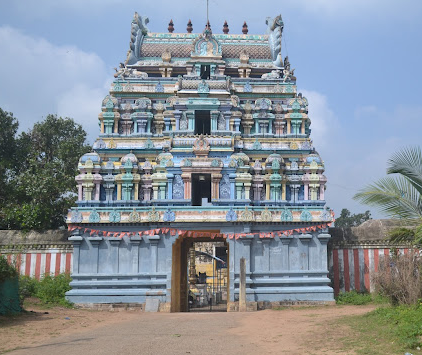The Brahmapureeswarar Temple is noted as one of the Mada temples built by the Chozha King Ko Chengat Chozha.It was later reconstructed as a stone temple during the early Chozha period and extended further during the reigns of the Pandyas, Vijayanagaras, and Marathas.
Sthala Puranam :
This temple, also known as Ampal Perunkoil, is steeped in rich legends and historical significance.
One of the well-known legends involves Brahma and Vishnu searching for the top and bottom of the fiery pillar from which Shiva emerged. Due to Brahma's false claim of having seen the top of the pillar, Shiva cursed him to take the form of a swan (the guise he had adopted for his quest). Regretting his actions, Brahma bathed in the temple tank and worshipped Shiva at this site to regain his original form.
In ancient times, the region was ruled by a king named Nandan, who faced a severe famine. Not knowing how to alleviate the suffering of his people, the righteous king prayed to Vinayakar at this temple for relief. In response, Vinayakar provided him with a padi (measuring cup) that filled itself each day, supplying enough food for the people. As a result, Vinayakar is affectionately referred to as Padikkasu Vinayakar.
The temple is also associated with Sage Durvasa, who had two sons, Ampara and Aampara, born of his servant. These asuras derived pleasure from troubling the sages. At Shiva’s request, Parvati sent Kali in the guise of a maid to confront them. Both brothers fought for her attention, resulting in the elder, Aampara, being killed by Kali, while Ampara was vanquished at the location now known as Ampakarathur. The names of these brothers give the place its name, Ampal (or Ambar). To atone for the sins of killing, Kali worshipped Shiva at this temple and received His blessings.
Another legend involves Kama, who was cursed by Sage Viswamitra for trying to disrupt his penance. As a result, Kama’s arrows lost their power. He sought relief from this curse by worshipping at this temple. Although a tale about Vimalan worshipping here instead of going to Kasi is often linked to this temple, it actually pertains to the Ampal Mahakala Nathar temple.
This temple is one of the maadakoils built by Kochchenga Cholan and is recognized as the last of the 78 maadakoils constructed by him. Somasi Maran Nayanar, one of the 63 Saivite Nayanmars, was born in nearby Makalam (an extension of Ampal) and spent much of his life associated with this temple. The architectural style of the temple clearly reflects the mediaeval Chola period, with three inscriptions referencing Raja Raja Chola and Kulothunga Chola III.
Interestingly, the temple features two Nandis—one made of stone and another of plaster, a more recent addition. Both, along with the dwajasthambam, are misaligned with the temple's axis from the entrance to the garbhagriha (sanctum sanctorum).
Administration History :
The temple is administered by the Hindu Religious and Charitable Endowments Department of the Government of Tamil Nadu. Historically, it was under the control of the Kochchenga Chola dynasty, known for constructing several significant temples. The temple's management has evolved through various periods, with inscriptions indicating royal patronage from rulers like Rajaraja Chola and Kulothunga Chola III. The temple continues to be an important religious and cultural centre, maintaining its heritage and traditions.
